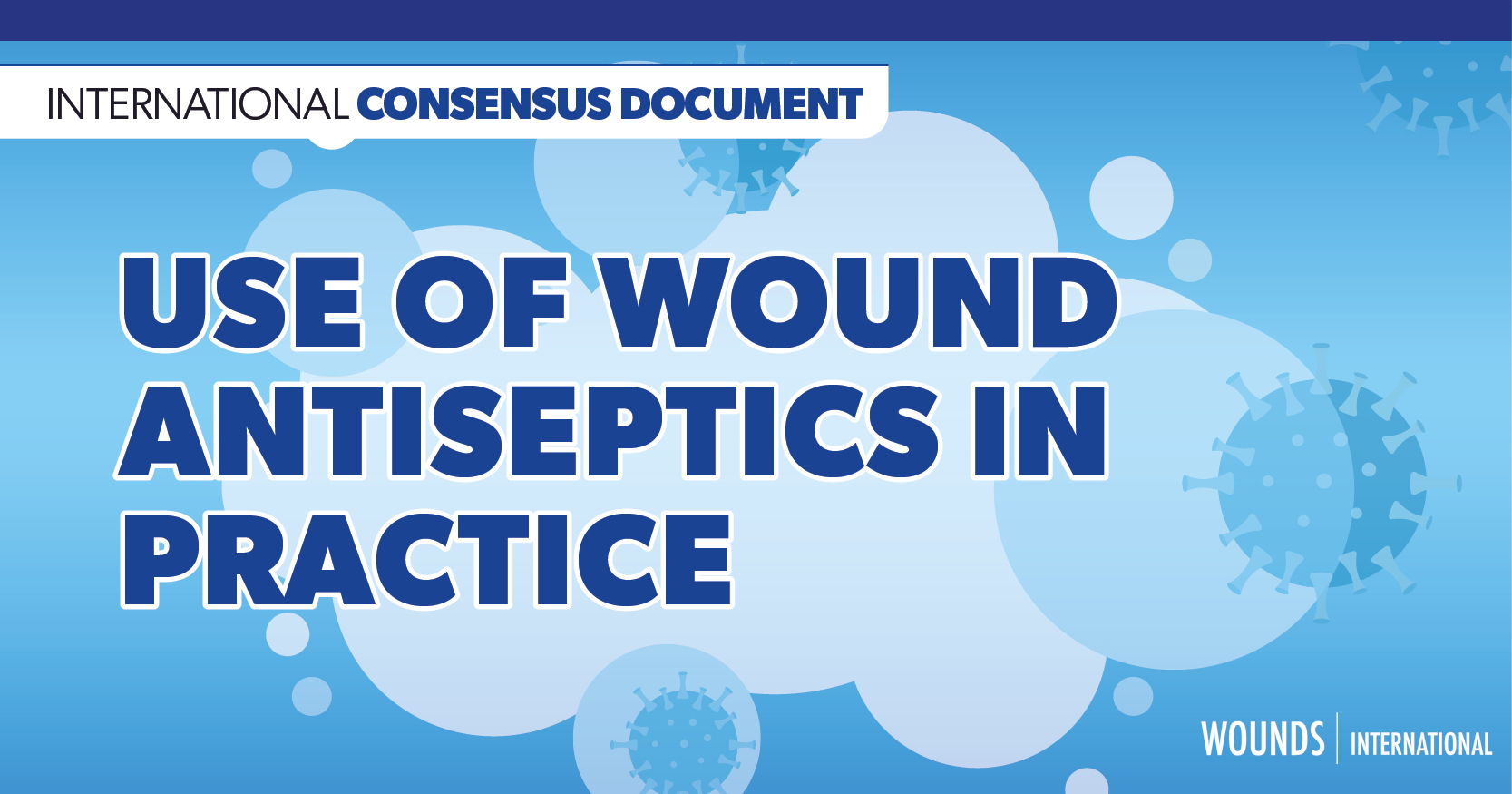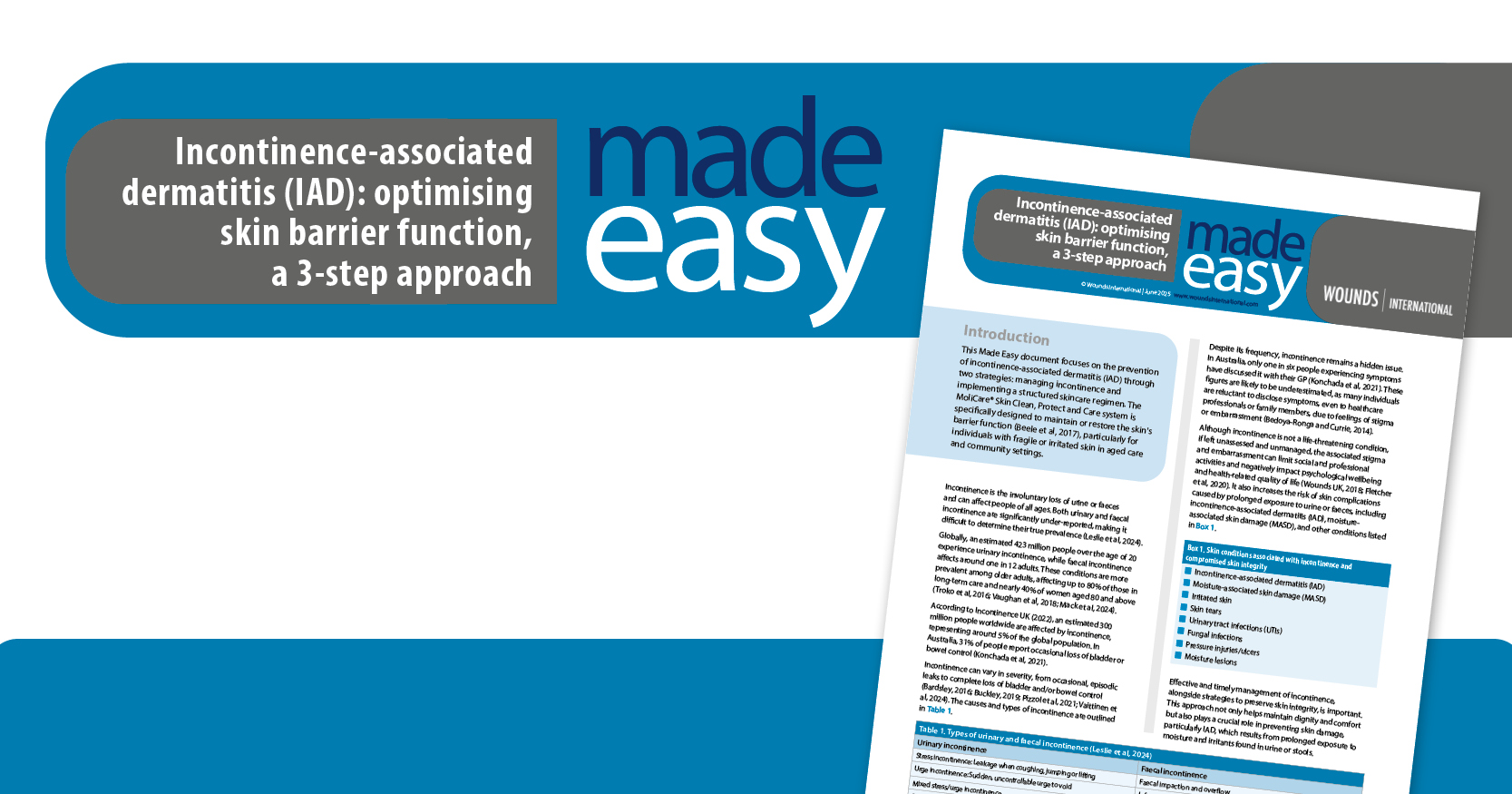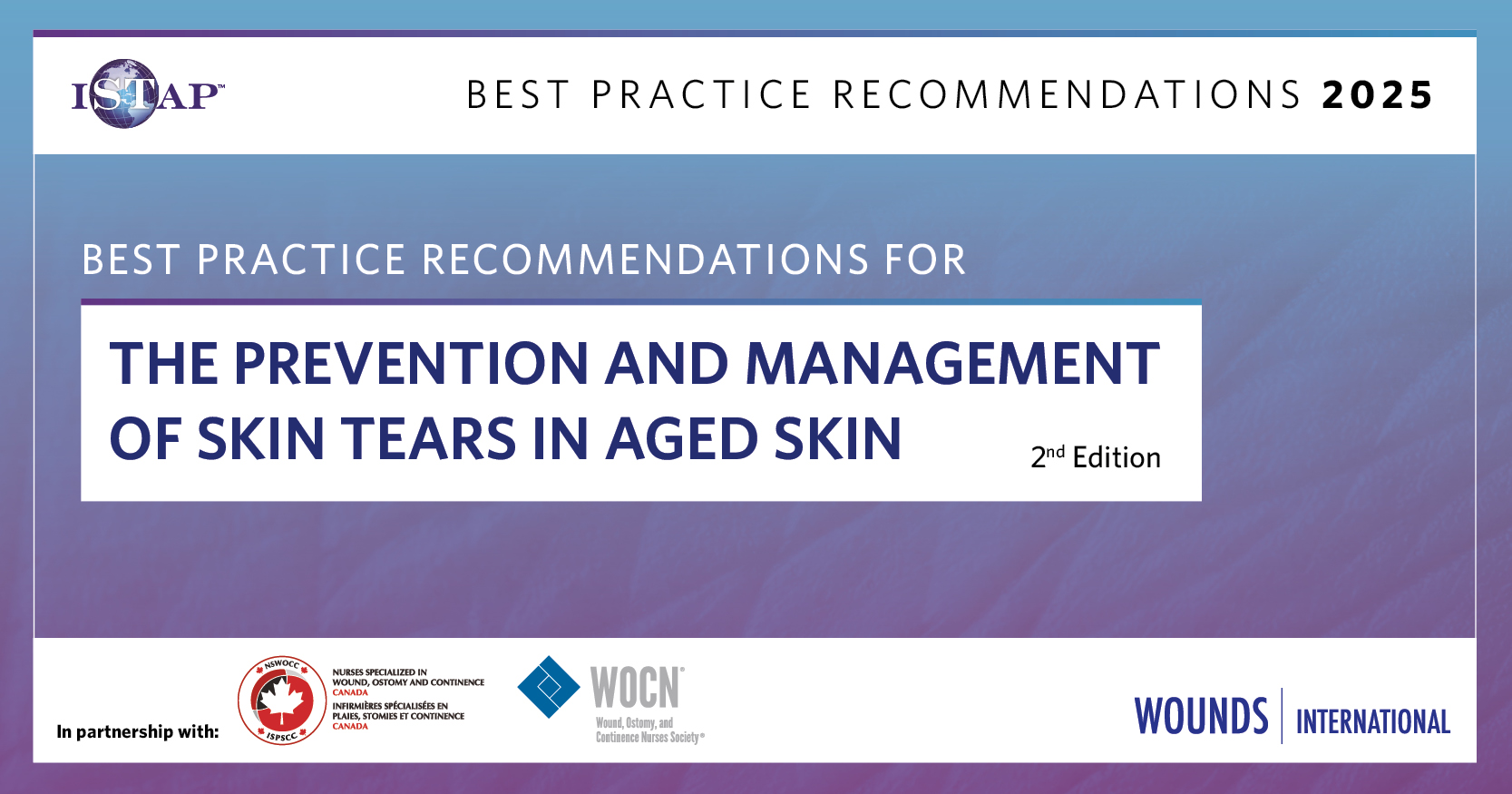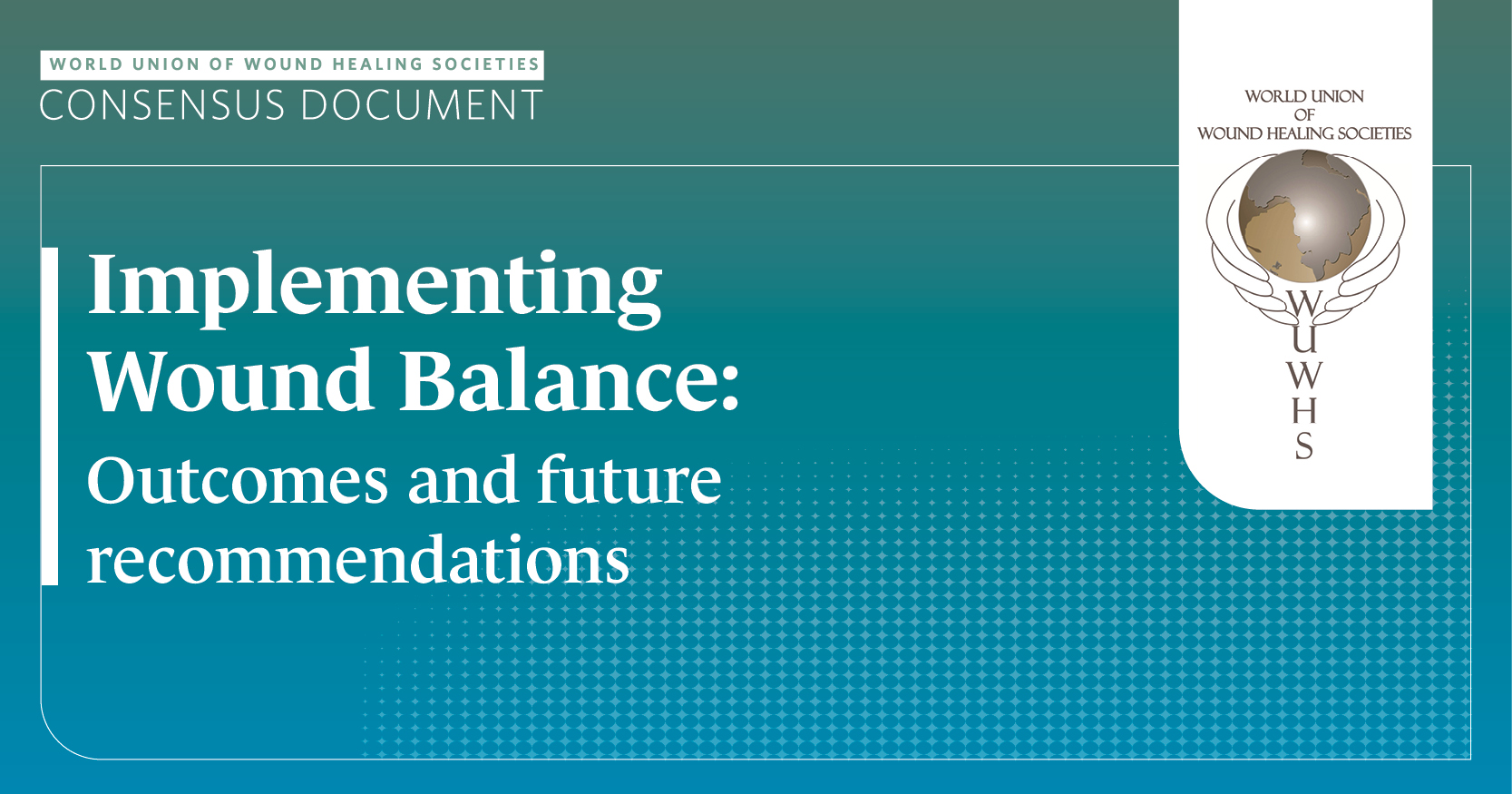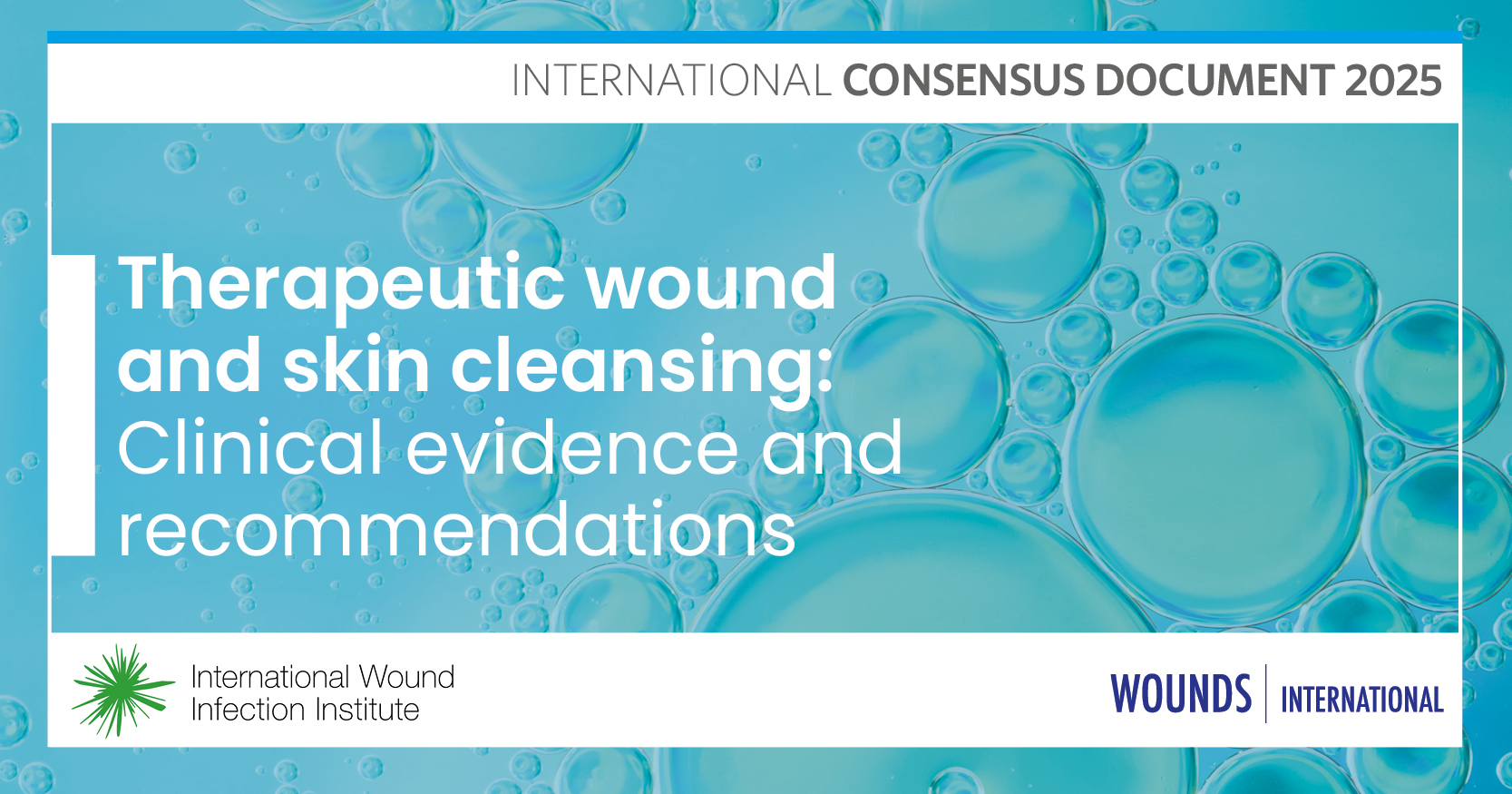ReferencesAlavi A, Maibach HI, eds (2020) Local Wound Care for Dermatologists. Springer Cham: 25-34
Alberto EC, Cardenas L, Cipolle M et al (2020) Level 1 Trauma Center Experience Utilizing Negative Pressure Wound Therapy with Instillation: Hypochlorous Acid versus Normal Saline Solution in Complex or Infected Wounds. Journal of Medical Science and Clinical Research 8(6): 414-20
Alvarez-Marin R, Aires-de-Sousa M, Nordmann P et al (2017) Antimicrobial activity of octenidine against multidrug-resistant Gram-negative pathogens. Eur J Clin Microbiol Infect Dis 36(12): 2379-83
Alves PJ, Barreto RT, Barrois BM et al (2021) Update on the role of antiseptics in the management of chronic wounds with critical colonisation and/or biofilm. Int Wound J 18(3): 342-58
Armstrong DG, Bohn G, Glat P et al (2015) Expert Recommendations for the Use of Hypochlorous Solution: Science and Clinical Application. Ostomy Wound Manage 61(5): S2-S19
Assadian O (2016) Octenidine dihydrochloride: chemical characteristics and antimicrobial properties. J Wound Care 25(3 Suppl): S3-6
Atkin L, Bucko Z, Conde Montero E et al (2019) Implementing TIMERS: the race against hard-to-heal wounds. J Wound Care 28(3): S1-S49
Ayello EA, Carville K, Fletcher J et al (2012) Appropriate use of silver dressings in wounds. An expert working group consensus. Wounds International
Ayello EA et al (2016) Wound Debridement, in Wound Care Essentials: Practice Principles. In Baranoski S and Ayello EA. (Eds)
Babalska ZŁ, Korbecka-Paczkowska M, Karpinski TM (2021) Wound Antiseptics and European Guidelines for Antiseptic Application in Wound Treatment. Pharmaceuticals (Basel) 14(12): 1253
Barreto R, Barrois B, Lambert J et al (2020) Addressing the challenges in antisepsis: focus on povidone iodine. Int J Antimicrob Agents 56(3): 106064
Barrigah-Benissan K, Ory J, Sotto A et al (2022) Antiseptic Agents for Chronic Wounds: A Systematic Review. Antibiotics (Basel) 11(3): 350
Barsoumian A, Sanchez CJ, Mende K et al (2013) In vitro toxicity and activity of Dakin’s solution, mafenide acetate, and amphotericin B on filamentous fungi and human cells. J Orthop Trauma 27(8): 428-36
Bednarek RS, Nassereddin A, Ramsey ML (2020) Skin Antiseptics. Available at: https://www.ncbi.nlm.nih.gov/books/NBK507853/ (accessed 13.09.2023)
Bellingeri A, Falciani F, Traspedini P et al (2016) Effect of a wound cleansing solution on wound bed preparation and inflammation in chronic wounds: a single-blind RCT. J Wound Care 25(3): 160-8
Bigliardi PL, Alsagoff SAL, El-Kafrawi HY et al (2017) Povidone iodine in wound healing: A review of current concepts and practices. Int J Surg 44: 260-68
Bogers SJ, van Daalen FV, Kuil SD et al (2019) Barriers and facilitators and the need for a clinical guideline for microbiological diagnostic testing in the hospital: a qualitative and quantitative study. Eur J Clin Microbiol Infect Dis 38(5): 913-20
Bongiovanni CM (2014) Effects of hypochlorous acid solutions on venous leg ulcers (VLU): experience With 1249 VLUs in 897 patients. J Am Coll Clin Wound Spec 6(3): 32-7
Bowers S, Franco E (2020) Chronic wounds: Evaluation and management. Am Fam Physician 101: 159-66
Brock AK, Chamoun-Emanuelli AM, Howard EA et al (2022) Wound swabs versus biopsies to detect methicillin resistant Staphylococcus aureus in experimental equine wounds. Vet Surg 51(8): 1196-205
Burchés-Feliciano MJ, Argente-Pla M, García-Malpartida K et al (2015) Hyperthyroidism induced by topical iodine. Endocrinol Nutr 62(9): 465-6
Centers for Disease Control and Prevention (2021) Expert Committee on Selection and Use of Essential Medicines. Available at: https://cdn.who.int/media/docs/default-source/essential-medicines/2021-eml-expert-committee/expert-reviews/a18_hypochlorous-acid_rev2.pdf?sfvrsn=cc8d0fb3_11 (accessed 03.10.2023)
Cheong JZA, Liu A, Rust CJ et al (2022) Robbing Peter to Pay Paul: Chlorhexidine gluconate demonstrates short-term efficacy and long-term cytotoxicity. Wound Rep Reg 30(5): 573-84
Conceição T, de Lencastre H, Aires-de-Sousa M (2019) Bactericidal activity of octenidine against Staphylococcus aureus harbouring genes encoding multidrug resistance efflux pumps. J Glob Antimicrob Resist 16: 239-41
Day A, Alkhalil A, Carney BC et al (2017) Disruption of Biofilms and Neutralization of Bacteria Using Hypochlorous Acid Solution: An In Vivo and In Vitro Evaluation. Adv Skin Wound Care 30(12): 543-51
De Francesco F, De Francesco M, Riccio M (2022) Hyaluronic Acid/Collagenase Ointment in the Treatment of Chronic Hard-to-Heal Wounds: An Observational and Retrospective Study. J Clin Med 11: 537
Del Rosso JQ, Bhatia N (2018) Status report on topical hypochlorous acid: clinical relevance of specific formulations, potential modes of action, and study outcomes. J Clin Aesthet Dermatol 11(11): 36-9
Dissemond J, Gerber V, Lobmann R et al (2020) Therapeutic index for local infections score (TILI): a new diagnostic tool. J Wound Care 29(12): 720-6
Dissemond J, Malone M, Ryan H et al (2022) Implementation of the M.O.I.S.T. concept for the local treatment of chronic wounds into clinical practice. Wounds International 13(4): 34-43
Dong D, Thomas N, Ramezanpour M et al (2020) Inhibition of Staphylococcus aureus and Pseudomonas aeruginosa biofilms by quatsomes in low concentrations. Exp Biol Med (Maywood) 245(1): 34-41
Eggers M, Koburger-Janssen T, Eickmann M, Zorn J (2018) In vitro bactericidal and virucidal efficacy of povidone-iodine gargle/mouthwash against respiratory and oral tract pathogens. Infect Dis Ther 7: 249-59
EPUAP/NPIAP/PPPIA (2019) Prevention and Treatment of Pressure Ulcers/Injuries: Clinical Practice Guideline. In Haesler E. (Ed)
Esposito S, De Simone G, Gioia R et al (2017) Deep tissue biopsy vs. superficial swab culture, including microbial loading determination, in the microbiological assessment of Skin and Soft Tissue Infections (SSTIs). J Chemother 29: 154-8
Falcone M, De Angelis B, Pea F et al (2021) Challenges in the management of chronic wound infections. J Glob Antimicrob Resist 26: 140-7
Food and Drug Administration (2022) FDA Drug Safety Podcast: FDA warns about rare but serious allergic reactions with the skin antiseptic chlorhexidine gluconate. Available at: https://www.fda.gov/drugs/fda-drug-safety-podcasts/fda-drug-safety-podcast-fda-warns-about-rare-serious-allergic-reactions-skin-antiseptic (accessed 22.09.2023)
Gil SB (2020) Implementing the Triangle of Wound Assessment framework to transform the care pathway for diabetic foot ulcers. J Wound Care 29(6): 363-9
Glaudemans AW, Uckay I, Lipsky BA et al (2015) Challenges in diagnosing infection in the diabetic foot. Diabet Med J Br Diabet Assoc 32: 748e59
Gmur M, Karpinski T (2020) Povidone-iodine in wound healing and prevention of wound infections. European Journal of Biological Research 10(3): 232-9
Gray MJ, Wholey W-Y, Jakob U (2013) Bacterial responses to reactive chlorine species. Annu Rev Microbiol 67: 141-60
Haalboom M, Blokhuis-Arkes MHE, Beuk RJ et al (2018) Wound swab and wound biopsy yield similar culture results: Culture results of swab versus biopsy. Wound Repair and Regeneration 26(2): 192-9
Haalboom M, Blokhuis-Arkes MHE, Beuk RJ et al (2019) Culture results from wound biopsy versus wound swab: does it matter for the assessment of wound infection? Clin Microbiol Infect 25(5): 629.e7-629.e12
Haesler E, Carville K (2023) Australian Standards for Wound Prevention and Management. Australian Health Research Alliance, Wounds Australia and WA Health Translation Network. Available at: https://woundsaustralia.org/int/woundsaus/uploads/Shop/Merchandise/2023%20wAustralian%20Standards%20for%20Wound%20Prevention%20and%20Management%204th%20(1).pdf (accessed 13.09.2023)
Haesler E, Swanson T, Ousey K et al (2022) Establishing a consensus on wound infection definitions. J Wound Care 31(Sup12): S48-S59
Harriott MM, Bhindi N, Kassis S et al (2019) Comparative antimicrobial activity of commercial wound care solutions on bacterial and fungal biofilms. Ann Plast Surg 83: 404–10
Hessam S, Sand M, Georgas D et al (2016) Microbial profile and antimicrobial susceptibility of bacteria found in inflammatory hidradenitis suppurativa lesions. Skin Pharmacol Physiol 29: 161-7
Hidalgo E, Bartolome R, Dominguez C (2002) Cytotoxicity mechanisms of sodium hypochlorite in cultured human dermal fibroblasts and its bactericidal effectiveness. Chem Biol Interact 139(3): 265-82
Høiby N, Bjarnsholt T, Moser C et al (2015) ESCMID guideline for the diagnosis and treatment of biofilm infections 2014. Clin Microbiol Infect 21(Suppl 1): S1-S25
International Wound Infection Institute (2022) Wound Infection in Clinical Practice. Wounds International
Johani K, Malone M, Jensen SO et al (2018) Evaluation of short exposure times of antimicrobial wound solutions against microbial biofilms: from in vitro to in vivo. J Antimicrob Chemother 73(2): 494-502
Kadam S, Shai S, Shahane A, Kaushik KS (2019) Recent advances in non-conventional antimicrobial approaches for chronic wound biofilms: have we found the ‘Chink in the armor’? Biomedicine 7(2): 3
Kapalschinski N, Seipp HM, Kückelhaus M et al (2017) Albumin reduces the antibacterial efficacy of wound antiseptics against Staphylococcus aureus. J Wound Care 26(4): 184-7
Kearns S, Dawson R Jr (2000) Cytoprotective effect of taurine against hypochlorous acid toxicity to PC12 cells. Adv Exp Med Biol 483: 563-70
Kiamco MM, Zmuda HM, Mohamed A et al (2019) Hypochlorous-Acid-Generating Electrochemical Scaffold for Treatment of Wound Biofilms. Sci Rep 9(1): 2683
Kim PJ, Applewhite A, Dardano AN et al (2018) Use of a Novel Foam Dressing With Negative Pressure Wound Therapy and Instillation: Recommendations and Clinical Experience. Wounds 30(3 suppl): S1-S17
Kordestani SS, Mohammadi FS, Noordadi M et al (2023) Wound Infection Detection Using a Rapid Biomarker. Adv Skin Wound Care 36(1): 35-40
Kramer A (2020) Case for wound cleansing. J Wound Care 29(Sup10a): S3-S4
Kramer A, Dissemond J, Kim S et al (2018) Consensus on Wound Antisepsis: Update 2018. Skin Pharmacol Physiol 31(1): 28-58
Laverty G, Gorman SP, Gilmore BF (2014) Biofilms and implant-associated infections. In: Cooper IB, Barnes L. eds, Biomaterials and Medical Device – Associated Infection. 1st edn. Woodhead
Leaper D, Assadian O, Edmiston CE (2015) Approach to chronic wound infections. Br J Dermatol 173: 351e8
Lepelletier D, Maillard JY, Pozzetto B, Simon A (2020) Povidone Iodine: Properties, Mechanisms of Action, and Role in Infection Control and Staphylococcus aureus Decolonization. Antimicrob Agents Chemother 64(9): e00682-20
Lescat M, Magnan M, Kenmoe S et al (2021) Co-Lateral Effect of Octenidine, Chlorhexidine and Colistin Selective Pressures on Four Enterobacterial Species: A Comparative Genomic Analysis. Antibiotics (Basel) 11(1): 50
Li JX, Pang YZ, Tang CS, Li ZQ (2004) Protective effect of taurine on hypochlorous acid toxicity to nuclear nucleoside triphosphatase in isolated nuclei from rat liver. World J Gastroenterol 10(5): 694-8
Limato R, Broom A, Nelwan EJ, Hamers RL (2022) A qualitative study of barriers to antimicrobial stewardship in Indonesian hospitals: governance, competing interests, cost, and structural vulnerability. Antimicrob Resist Infect Control 11(1): 85
Lipsky BA, Dryden M, Gottrup F et al (2016) Antimicrobial stewardship in wound care: a Position Paper from the British Society for antimicrobial Chemotherapy and European wound management Association. J Antimicrob Chemother 71: 3026e35
Lutz JT, Diener IV, Freiberg K et al (2016) Efficacy of two antiseptic regimens on skin colonization of insertion sites for two different catheter types: a randomized, clinical trial. Infection 44(6): 707-12
Mangum LC, Franklin NA, Garcia GR et al (2018) Rapid degradation and non-selectivity of Dakin’s solution prevents effectiveness in contaminated musculoskeletal wound models. Injury 49(10): 1763-73
Malanovic N, Buttress JA, Vejzovic D et al (2022) Disruption of the Cytoplasmic Membrane Structure and Barrier Function Underlies the Potent Antiseptic Activity of Octenidine in Gram-Positive Bacteria. Appl Environ Microbiol 88(10): e0018022
Malanovic N, Ön A, Pabst G et al (2020) Octenidine: Novel insights into the detailed killing mechanism of Gram-negative bacteria at a cellular and molecular level. Int J Antimicrob Agents 56(5): 106146
Malone M et al (2017) The prevalence of biofilms in chronic wounds: a systematic review and meta-analysis of published data. Journal of Wound Care 26: 20-5
Matiasek J et al (2018b) An intra-individual surgical wound comparison shows that octenidine-based hydrogel wound dressing ameliorates scar appearance following abdominoplasty. International Wound Journal 15: 914-20
Matiasek J, Kienzl P, Otti GR et al (2018a) Aseptic surgical preparation for upper eyelid blepharoplasty via full-face octenidine antiseptic without antibiotic medication shows effective prophylaxis against post-surgical wound infection. Int Wound J 15(1): 84-9
Mota FAR, Pereira SAP, Araújo ARTS et al (2021) Biomarkers in the diagnosis of wounds infection: An analytical perspective. TrAC Trends in Analytical Chemistry 143(17): 116405
Müller G, Kramer A (2008) Biocompatibility index of antiseptic agents by parallel assessment of antimicrobial activity and cellular cytotoxicity. J Antimicrob Chemother 61(6): 1281-7
Murphy C, Atkin L, Hurlow J et al (2021) Wound hygiene survey: awareness, implementation, barriers and outcomes. J Wound Care 30(7): 582-90
Nair HKR, Choudhury S, Ramachandram K et al (2019) Investigation and review on the efficacy of super-oxidized solution (HYDROCYN aqua®) against biofilm. Wounds International 10(4): 62-6
Nair HKR, Krishnen R, Wahab NAB et al (2023) Use of electroactivated super-oxidised water (HYDROCYN aqua®) as a wound cleanser in the treatment of hard-to-heal wounds: a case series. Wounds International 6(1): 43-9
National Institute for Health and Care Excellence (2023) Antimicrobial stewardship. Available at: https://bnf.nice.org.uk/medicines-guidance/antimicrobial-stewardship/ (accessed 11.09.2023)
Nikolić N, Kienzl P, Tajpara P et al (2019) The Antiseptic Octenidine Inhibits Langerhans Cell Activation and Modulates Cytokine Expression upon Superficial Wounding with Tape Stripping. J Immunol Res 2019(9): 1-11
Norman G, Dumville JC, Moore ZE et al (2016) Antibiotics and antiseptics for pressure ulcers. Cochrane Database Syst Rev 4(4): CD011586
Olszowski S, Mak P, Olszowska E, Marcinkiewicz J (2003) Collagen type II modification by hypochlorite. Acta Biochim Pol 50(2): 471-9
Omar A, Wright JB, Schultz G et al (2017) Microbial biofilms and chronic wounds. Microorganisms 5(1): 9
Ortega-Llamas L, Quiñones-Vico MI, García-Valdivia M et al (2022) Cytotoxicity and Wound Closure Evaluation in Skin Cell Lines after Treatment with Common Antiseptics for Clinical Use. Cells 11(9): 1395
Ortega-Peña S, Hidalgo-González C, Robson MC, Krötzsch E (2017) In vitro microbicidal, anti-biofilm and cytotoxic effects of different commercial antiseptics. Int Wound J 14(3): 470-9
Ousey K, Blackburn J (2020) Understanding antimicrobial resistance and antimicrobial stewardship in wound management. Wounds UK 16(2): 36-9
Pareek V, Devineau S, Sivasankaran SK et al (2021) Silver Nanoparticles Induce a Triclosan-Like Antibacterial Action Mechanism in Multi-Drug Resistant Klebsiella pneumoniae. Front Microbiol 12: 638640
Pattison DI, Hawkins CL, Davies MJ (2003) Hypochlorous acid-mediated oxidation of lipid components and antioxidants present in low-density lipoproteins: absolute rate constants, product analysis, and computational modeling. Chem Res Toxicol 16(4): 439-49
Patton D, Avsar P, Sayeh A et al (2023) A meta-review of the impact of compression therapy on venous leg ulcer healing. Int Wound J 20(2): 430-47
Pitten FA, Werner HP, Kramer AA (2003) Standardized Test to Assess the Impact of Different Organic Challenges on the Antimicrobial Activity of Antiseptics. J Hosp. Infect 55: 108-15
Ponnachan P et al (2019) Antifungal activity of octenidine dihydrochloride and ultraviolet-C light against multidrug-resistant Candida auris. Journal of Hospital Infection 102: 120-4
Power G, Moore Z, O’Connor T (2017) Measurement of pH, exudate composition and temperature in wound healing: a systematic review. J Wound Care 26: 381-97
Punjataewakupt A, Napavichayanun S, Aramwit P (2019) The downside of antimicrobial agents for wound healing. Eur J Clin Microbiol Infect Dis 38(1): 39-54
Radischat N, Augustin M, Herberger K et al (2020) Influence of human wound exudate on the bactericidal efficacy of antiseptic agents in quantitative suspension tests on the basis of European Standards (DIN EN 13727). Int Wound J 17(3): 781-9
Rembe JD, Huelsboemer L, Plattfaut I et al (2020) Antimicrobial Hypochlorous Wound Irrigation Solutions Demonstrate Lower Anti-biofilm Efficacy Against Bacterial Biofilm in a Complex in-vitro Human Plasma Biofilm Model (hpBIOM) Than Common Wound Antimicrobials. Front Microbiol 11: 564513
Rippon MG, Rogers AA, Ousey K (2023) Polyhexamethylene biguanide and its antimicrobial role in wound healing: a narrative review. J Wound Care 32(1): 5-20
Roberts CD, Leaper DJ, Assadian O (2017) The Role of Topical Antiseptic Agents Within Antimicrobial Stewardship Strategies for Prevention and Treatment of Surgical Site and Chronic Open Wound Infection. Adv Wound Care (New Rochelle) 6(2): 63-71
Robson MC (2020) Treating chronic wounds with hypochlorous acid disrupts biofilm. Wound Prevention and Management 66(5): 9-10
Rolfe R Jr, Kwobah C, Muro F et al (2021) Barriers to implementing antimicrobial stewardship programs in three low- and middle-income country tertiary care settings: findings from a multi-site qualitative study. Antimicrob Resist Infect Control 10(1): 60
Rothenberger J, Krauss S, Tschumi C et al (2016) The effect of Polyhexanide, Octenidine Dihydrochloride, and tea tree oil as topical antiseptic agents on in vivo microcirculation of the human skin: a noninvasive quantitative analysis. Wounds 28(10): 341-46
Rutter L (2018) Identifying and managing wound infection in the community. Br J Community Nurs 23(Sup3): S6-S14
Sakarya S, Gunay N, Karakulak M et al (2014) Hypochlorous acid: an ideal wound care agent with powerful microbicidal, antibiofilm, and wound healing potency. Wounds 26(12): 342–50
Schaper NC, van Netten JJ, Apelqvist J et al (2020) IWGDF Editorial Board. Practical guidelines on the prevention and management of diabetic foot diseases (IWGDF 2019 update). Diabetes Metab Res 36: e3266
Schultz G, Bjarnsholt T, James GA et al (2017) Global Wound Biofilm Expert Panel. Consensus guidelines for the identification and treatment of biofilms in chronic nonhealing wounds. Wound Repair Regen 25(5): 744-57
Schultz GS, Sibbald RG, Falanga V et al (2003) Wound bed preparation: a systematic approach to wound management. Wound Repair Regen 11: 1–28
Schwarzer S, James GA, Goeres D et al (2020) The efficacy of topical agents used in wounds for managing chronic biofilm infections: A systematic review. J Infect 80(3): 261-70
Seiser S, Janker L, Zila N et al (2021) Octenidine-based hydrogel shows anti-inflammatory and protease-inhibitory capacities in wounded human skin. Sci Rep 11(1): 32
Severing AL, Rembe JD, Koester V, Stuermer EK (2019) Safety and efficacy profiles of different commercial sodium hypochlorite/hypochlorous acid solutions (NaClO/HClO): antimicrobial efficacy, cytotoxic impact and physicochemical parameters in vitro. J Antimicrob Chemother 74: 365-72
Shamsian N (2021) Wound bed preparation: an overview. Br J Community Nurs 1;26(Sup9): S6-S11
Sharma S (2018) Association of postoperative wound infection with malnutrition and low socio-economic status. Journal of Medical Science and Clinical Research 6(3): 785-8
Sibbald RG, Elliott JA, Persaud-Jaimangal R et al (2021) Wound Bed Preparation 2021. Adv Skin Wound Care 34: 183-95
Sibbald RG, Goodman L, Woo KY et al (2011) Special considerations in wound bed preparation 2011: an update. Adv Skin Wound Care 24(9): 415-36
Skodvin B, Wathne JS, Lindemann PC et al (2019) Use of microbiology tests in the era of increasing AMR rates- a multicentre hospital cohort study. Antimicrob Resist Infect Control 8: 28
Snyder RJ, Bohn G, Hanft J et al (2017) Wound biofilm: current perspectives and strategies on biofilm disruption and treatments. Wounds 29: S1–17
Sopata M, Jawien A, Mrozikiewicz-Rakowska B et al (2020) Guidelines for local management of uninfected wounds, wounds at risk of infection and infected wounds— An overview of the available antimicrobial substances used in the treatment of wounds. Recommendations of the Polish Wound Treatment Society. Leczenie Ran 17: 1-21
Spettel K, Bumberger D, Camp I et al (2022) Efficacy of octenidine against emerging echinocandin-, azole- and multidrug-resistant Candida albicans and Candida glabrata. Journal of Global Antimicrobial Resistance 29: 23-8
Stryja J, Sandy-Hodgetts K, Collier M et al (2020) Surgical site infection: preventing and managing surgical site infection across health care sectors. J Wound Care 29: 2 (Suppl 2b): S1–69
Stuermer EK, Besser M, Brill F et al (2021) Comparative analysis of biofilm models to determine the efficacy of antimicrobials. Int J Hyg Environ Health 234: 113744
Sun X, Chen J, Zhang J et al (2016) Maggot debridement therapy promotes diabetic foot wound healing by up-regulating endothelial cell activity. J Diabetes Complicat 30: 318-22
Tegl G, Schiffer D, Sigl E, Heinzle A, Guebitz GM (2015) Biomarkers for infection: enzymes, microbes, and metabolites. Appl Microbiol Biotechnol 99: 4595–614
To E, Dyck R, Gerber S et al (2016) The Effectiveness of Topical Polyhexamethylene Biguanide (PHMB) Agents for the Treatment of Chronic Wounds: A Systematic Review. Surg Technol Int 29: 45-51
Vouillarmet J, Bourron O, Gaudric J et al (2016) Lower-extremity arterial revascularization: Is there any evidence for diabetic foot ulcer-healing? Diabetes Metab 42: 4–15
Wang L, Bassiri M, Najafi R et al (2007) Hypochlorous acid as a potential wound care agent: part I. Stabilized hypochlorous acid: a component of the inorganic armamentarium of innate immunity. J Burns Wounds 6: e5
Wei J, He L, Weng F, Huang F, Teng P (2021) Effectiveness of chlorhexidine in preventing infections among patients undergoing cardiac surgeries: a meta-analysis and systematic review. Antimicrob Resist Infect Control 10(1): 140
Wolcott RD, Hanson JD, Rees EJ et al (2016) Analysis of the chronic wound microbiota of 2,963 patients by 16S rDNA pyrosequencing. Wound Repair Regen 24(1): 163-74
World Health Organization (2016) Diagnostic stewardship: a guide to implementation in antimicrobial resistance surveillance sites. Available at: https://apps.who.int/iris/bitstream/handle/10665/251553/WHO-DGO-AMR-2016.3-eng.pdf (accessed 11.09.2023)
World Health Organization (2019) Antimicrobial stewardship programmes in health-care facilities in low- and middle-income countries: A WHO practical toolkit. Available at: https://apps.who.int/iris/bitstream/handle/10665/329404/9789241515481-eng.pdf (accessed 11.09.2023)
World Health Organization (2022) The WHO AWaRe (Access, Watch, Reserve) antibiotic book. Available at: https://www.who.int/publications/i/item/9789240062382 (accessed 11.09.2023)
Worsley A, Vassileva K, Tsui J et al (2019) Polyhexamethylene Biguanide:Polyurethane Blend Nanofibrous Membranes for Wound Infection Control. Polymers (Basel) 11(5): 915
Wounds International (2023) Hydrocyn Aqua® Made Easy. Wounds International
Wounds UK (2020) Best Practice Statement: Antimicrobial stewardship strategies for wound management. Wounds UK
Wounds UK (2021) Wound bed preparation made easy. Wounds UK
Winterbourn CC, Brennan SO (1997) Characterization of the oxidation products of the reaction between reduced glutathione and hypochlorous acid. Biochem J 326: 87-92
Wu S, Tannous E, Haldane V et al (2022) Barriers and facilitators of implementing interventions to improve appropriate antibiotic use in low- and middle-income countries: a systematic review based on the Consolidated Framework for Implementation Research. Implement Sci 17(1): 30
Zhang Y, Lin B, Huang R et al (2021) Flexible integrated sensing platform for monitoring wound temperature and predicting infection. Microb Biotechnol 14(4): 1566-79
Zhu X, Olsson MM, Bajpai R et al (2022) Health-related quality of life and chronic wound characteristics among patients with chronic wounds treated in primary care: A cross-sectional study in Singapore. Int Wound J 19(5): 1121-32

